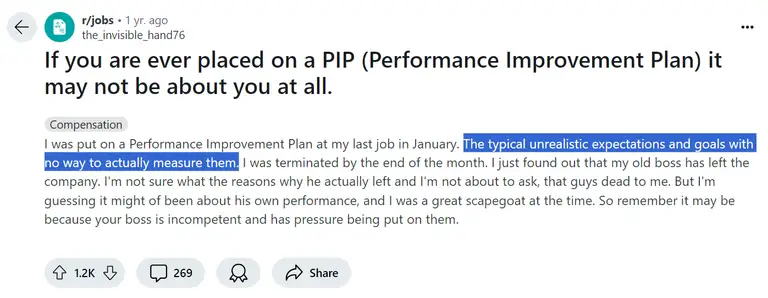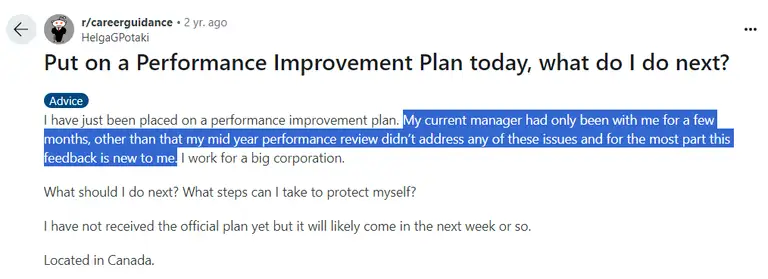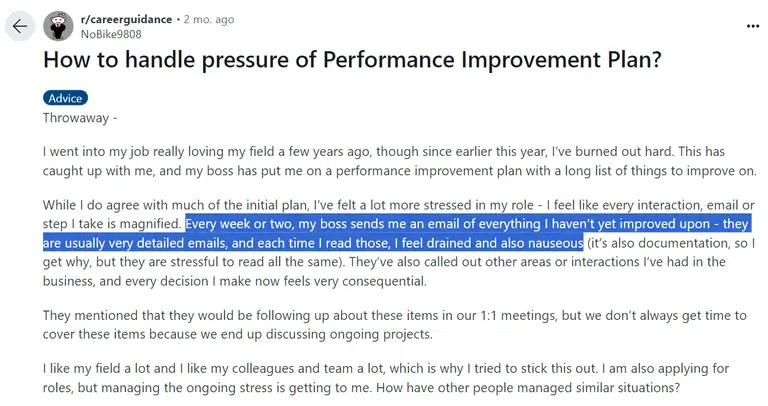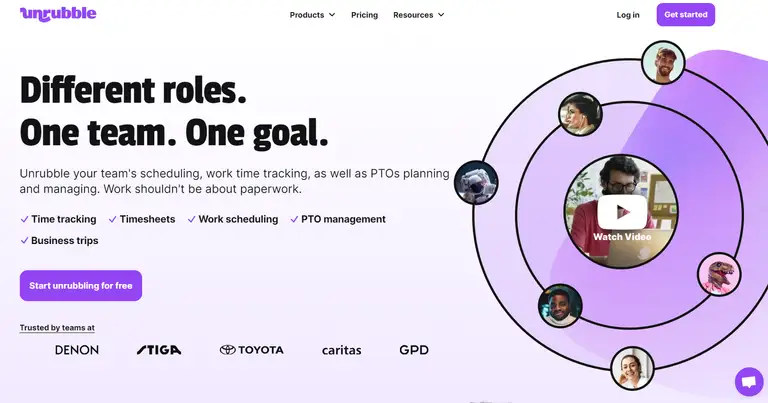"I don't know a single person who made it out of a PIP without getting fired."
This might sound like a grim statement, but it's a sentiment shared by many.
Performance Improvement Plans (PIPs) often carry a bad reputation, but they don't have to end in termination.
The truth is, the outcome depends a lot on how you, as an employer, handle the process.
If you want to avoid a situation where a PIP feels like a one-way ticket out the door, this article is for you:
What is a Performance Improvement Plan (PIP)?

A Performance Improvement Plan (PIP) is a formal tool used to address an employee's current performance issues.
It's a structured process that helps an employee succeed by laying out clear and measurable objectives they need to meet within a specific timeframe.
Think of it as a roadmap that guides the employee through the necessary steps to get back on track.
For small business owners, dealing with poor performance can be tricky. You don’t want to lose a valued employee, but you also need them to meet expectations. A PIP gives you a chance to outline what needs fixing while allowing the employee to get better.
Why bother with a Performance Improvement Plan? Here’s the deal
If you don't have a PIP yet, you might want to change it very soon for the following reasons:
Set clear expectations
Gallup's research shows many employees don't know what's expected of them at work. One of the main reasons to use a performance improvement plan is to change this.
Sometimes, an employee's performance might be lacking simply because they don’t fully understand what’s expected of them.
A PIP lays it all out in black and white - what they need to achieve and how they can get there. This clarity makes a big difference in turning things around.
Adopt a structured approach to improvement
A PIP isn’t just a list of complaints. It’s an approach to improvement that is actually scientifically proven to benefit both employees and employers.
As a result of following the PIP process, you’re not only giving them a fair chance to meet the goals you’ve set, but also strengthening their connection to your business 70% of the time.
This isn’t just about today’s problems - it’s also about developing employees for the future. With SMART objectives, you can track an employee’s progress over time and make adjustments as needed.
Enhance communication
It's been verified that communication issues are one of the biggest reasons for workplace disputes.
A PIP opens the door for better conversations between you and your employee.
Look at it as your chance to talk openly about what’s not working and what needs to change. This process can improve overall communication and help the employee understand the bigger picture.
Be fair
If an employee fails to meet performance expectations, a PIP gives you a fair and documented reason to take further action, if needed.
It shows that you’ve tried to help the employee by giving them a clear path to improvement.
Having everything in writing can protect your business in case you need to make tough decisions later on.
Invest in employee growth
A PIP is also about investing in your team. One study shows that giving employees a chance to improve can help reach important goals.
These goals include boosting employee morale, making them feel more secure, and increasing engagement. It also helps them develop the skills they need to do their job well.
Performance improvement plan examples show that, when done right, they can lead to great results.
Performance Improvement Plans: a boost or a bust?
Before you create your first pip ever, you should be aware of the potential drawbacks it might come with.
We've gathered the most commonly mentioned ones across the web:
Short-term focus
Performance Improvement Plans (PIPs) can sometimes have a short-term focus. They’re designed to fix immediate issues, but this might not address underlying problems. If the root cause of an employee’s performance issues isn’t tackled, the improvements might not last.
Potential for low morale
A PIP can sometimes backfire and affect employee morale. If not handled carefully, employees might see it as a sign they’re not valued or that their job is at risk. It’s key to balance the plan with positive encouragement to keep motivation high.

Risk of unclear goals
Without clear goals, a PIP can become frustrating. If the objectives aren’t well-defined or measurable, employees might struggle to understand what’s expected. This lack of clarity can lead to confusion and even more performance issues.

Communication hurdles
Communication is key in any PIP, but it can sometimes be a hurdle. If not done right, feedback and expectations might be completely misunderstood. That's what happened in the case of HelgaGPotaki - a Reddit community member who shared their pip experience.
Regular, clear communication is needed to guide the employee through the process and make sure everyone is on the same page.

Limited improvement time
The timeline for a PIP can be a challenge. If an employee has limited time to make improvements, the pressure can make them feel drained and even nauseous. This tight schedule might not give them enough room to truly address their weaknesses and show real progress.
As a matter of fact, some studies show that PIPs don't improve employee performance and productivity.

10 steps to building a performance improvement plan that delivers
PIPs can either lift your company up or drag it down - it all depends on how you handle them.
But don’t worry, we’ve got the secrets to making them work in your favor.
In the next 10 steps, we’ll show you how to create a performance improvement plan that gets real results.
And to make it easier, we've designed a fictional scenario so you can see how each step could play out in real life.
Identify the issues
Start by pinpointing exactly where the employee’s performance is falling short. This could come from recent performance reviews or feedback from colleagues. Be specific about what needs to improve so you can tackle the right issues.
Imagine Sarah, a project manager at a small marketing firm. Her latest performance reviews show she’s been struggling with meeting deadlines and managing her team’s communication.
Team members have reported confusion and missed updates. Clearly, Sarah’s performance needs improvement in these areas.
Set clear goals
Once you’ve identified the issues, set clear and achievable goals. These should be specific, measurable, and time-bound. For example, if an employee’s communication skills need work, a goal might be to complete a communication skills workshop within the next three months.
To address these issues, her supervisor, Mark, sets specific goals. Sarah needs to complete project milestones on time and improve team communication. The goals are to finish the next three projects by their deadlines and implement weekly team meetings to track progress and share updates.
Outline a plan
Map out how the employee will meet these goals. Break down the steps they need to take and the resources they’ll need. This plan should be easy to follow and should outline what success looks like for each goal.
Mark and Sarah work together to outline a plan. They decide Sarah will use time management software to keep track of deadlines and schedule weekly team meetings. They also agree that Sarah will attend a workshop on effective team communication to help her manage her team better.
Communicate clearly
Sit down with the employee to discuss the PIP. Make sure they understand what’s expected and how they can achieve these goals. Good communication is key here - verify whether the employee feels they have all the information they need to succeed.
Mark sits down with Sarah to discuss the PIP. He explains why these changes are necessary and how the goals were set. They go over the plan in detail, making sure Sarah understands each step and how it will help improve her performance. Mark reassures Sarah that he’s there to support her throughout the process.
Offer support
Show that you’re committed to helping the employee improve. This could mean offering additional training, mentoring, or regular check-ins. Support shows that you’re invested in their progress and success.
To help Sarah meet her goals, Mark arranges for her to have weekly check-ins with him. They use these meetings to discuss her progress, tackle any challenges she faces, and adjust the plan if needed.
Mark also encourages Sarah to reach out if she needs extra help with the new software or the communication workshop.
Monitor progress regularly
Keep track of how the employee is doing as they work through the PIP. Schedule regular check-ins to discuss their progress and any challenges they’re facing. This helps keep the plan on track and allows for adjustments if needed.
As the weeks go by, Mark keeps an eye on Sarah’s progress. They have their scheduled check-ins, where Sarah updates him on the project milestones and how the team meetings are going. Mark notes improvements and provides feedback on areas where Sarah still needs to improve.
Provide constructive feedback
Give feedback that’s specific and helpful. Instead of just pointing out what’s wrong, explain how they can improve. This will help the employee understand what they’re doing well and where they need to make changes.
During their check-ins, Mark gives Sarah specific feedback. For instance, he might say, “The time tracking tool is helping you meet deadlines, but your team meeting updates could be more detailed.” He also praises her for the positive changes, like her effort to keep the team informed.
Adjust goals if necessary
Sometimes, goals may need to be adjusted based on the employee’s progress or changes in the business. Be flexible and willing to modify the plan. That's how you make sure it remains relevant and achievable.
A few weeks into the PIP, Sarah encounters a challenge with the software that wasn’t anticipated. Mark adjusts the plan to include additional training for Sarah on the software and extends the deadline for one project to give her more time to adapt.
Evaluate the outcome
At the end of the PIP period, evaluate the employee’s performance against the goals set. This is a chance to see if the plan worked and whether the employee has made the necessary improvements.
As Sarah’s PIP period comes to an end, Mark reviews her performance. He compares her progress to the goals they set together - finishing projects on time and improving team communication.
Mark notices that Sarah has successfully met her project deadlines and that the team meetings have become more effective and well-organized. The improvements are clear, and it’s evident that the PIP has made a positive difference in Sarah’s performance.
Decide on next steps
Based on the evaluation, decide what happens next. If the employee has made progress, discuss how to build on these improvements. If not, consider other options, such as further training or different roles within the company.
Based on this evaluation, Mark decides to build on Sarah’s progress. They discuss new goals, such as leading a project team with increased responsibilities.
If Sarah hadn’t shown improvement, Mark would have considered other options, like further training or a different role. But with her progress, the focus shifts to encouraging her continued growth and setting her up for future success.
Improve employee performance with this PIP template
We’ve created this Performance Improvement Plan (PIP) template just for you.
If you’re ready to tackle performance issues and help your team perform well, make use of it.
It’s packed with the steps we've just described above.
Download it now for free and watch your team’s performance get better every day:
Performance Improvement Plan (PIP)
Employee Name: [Employee’s Name]
Job Title: [Employee’s Job Title]
Department: [Department Name]
Supervisor/Manager: [Supervisor’s Name]
Date of Plan Initiation: [Start Date]
Review Date: [Review Date]
1. Identify the issues
Description of Performance Issues:
[List specific areas where the employee’s performance is falling short. Include examples and any feedback received.]
Impact on Team/Department:
[Describe how the performance issues affect the team or department.]
2. Set clear goals
Goal 1:
[State the first clear, measurable, and achievable goal.]
Goal 2:
[State the second clear, measurable, and achievable goal.]
Goal 3 (if applicable):
[State any additional goals.]
3. Outline a plan
Action Steps for Goal 1:
[List specific steps the employee will take to meet this goal.]
Action Steps for Goal 2:
[List specific steps the employee will take to meet this goal.]
Action Steps for Goal 3 (if applicable):
[List specific steps the employee will take to meet this goal.]
Resources and Support:
[Detail any resources or support available to the employee, such as training, tools, or mentoring.]
4. Communicate clearly
Initial Meeting Date:
[Date of the meeting where the PIP was discussed with the employee.]
Key Points Discussed:
[Summarize the main points covered in the discussion, including the goals and action steps.]
Employee’s Acknowledgment:
[Note the employee’s understanding of the plan and any initial feedback they provided.]
5. Offer support
Support Plan:
[Detail the support that will be provided, such as regular check-ins, additional training, or resources.]
Frequency of Check-Ins:
[Specify how often you will meet with the employee to discuss progress.]
6. Monitor progress regularly
Monitoring Schedule:
[Outline the schedule for reviewing progress, including dates for regular check-ins and interim reviews.]
Progress Tracking:
[Describe how progress will be tracked and documented.]
7. Provide constructive feedback
Feedback Schedule:
[Outline when and how feedback will be given during the PIP process.]
Types of Feedback:
[Specify the type of feedback the employee will receive, including positive reinforcement and areas needing improvement.]
8. Adjust goals if necessary
Criteria for Adjustment:
[Describe the conditions under which goals may be adjusted.]
Process for Adjustment:
[Explain how adjustments to the goals or plan will be made, including who will be involved in this decision.]
9. Evaluate the outcome
Evaluation Date:
[Date when the final evaluation will be conducted.]
Criteria for Success:
[List the criteria that will be used to determine whether the employee has successfully met the goals.]
Final Evaluation Summary:
[Provide a summary of the employee’s performance and progress made during the PIP period.]
10. Decide on next steps
Next Steps Based on Evaluation:
[Outline the next steps depending on the evaluation outcome. This may include setting new goals, additional training, or other actions.]
Follow-Up Plan:
[Describe any follow-up actions, such as continued support or further reviews.]
Employee Signature: [Employee’s Signature]
Date: [Date]
Supervisor/Manager Signature: [Supervisor’s Signature]
Date: [Date]
How to avoid enforcing a PIP?
Many of the reasons why companies end up enforcing a Performance Improvement Plan (PIP) can actually be avoided with the right tools in place.
Typically, PIPs are triggered by issues like poor job performance, frequent absenteeism, missed deadlines, or poor time management.
But what if you could eliminate these problems before they even start?
That’s where Unrubble comes in:
- With Unrubble’s precise Time Tracking, you can monitor work hours, spot lateness, and track overtime. This helps nip poor time management in the bud.
- Thanks to Scheduling with drag-and-drop simplicity your team knows exactly when and where they’re needed, and they don't miss deadlines.
- With the PTO Tracker, managing absences, vacations, and work-from-home requests is smooth and transparent. No more unexpected absenteeism.
- Our Mobile Time Clock guarantees accurate clock-ins, while the Employee Self-Service App keeps everyone in the loop with real-time updates for reduced misunderstandings that could lead to poor performance.

So, instead of waiting for issues to pile up and enforcing a PIP, use Unrubble to keep your team on track from day one.
The result? A more productive, engaged workforce - and fewer reasons to ever need a PIP in the first place.
Try it for free today.
Other than that, good luck with your PIPs and don’t forget to check our blog out for more interesting articles.








